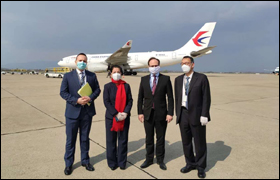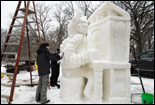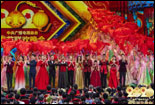Koje su kulturne i obrazovne aktivnosti bile organizirane u Kini u svrhu podrške rata otpora i na koji način?

Foto: Arhiva
After the outbreak of the nationwide War of Resistance, a Chinese united front was quickly formed bringing those from different cultural circles together. People from China's cultural and education sectors, motivated by a strong sense of patriotism, actively engaged in initiatives to spread the word about the resistance, encouraging people to stand up against the Japanese invasion. Theirs too became an important front in the Chinese War of Resistance.
On July 15, 1937, the China Playwrights Association was founded in Shanghai. It was not long before it had created and brought to the stage a play named Defend the Lugou Bridge ("Lugou Bridge" is sometimes known in English as the "Marco Polo Bridge"). The play had a positive influence, encouraging people to resist the Japanese invasion and protect their nation.
July 28, 1937 saw the official founding of the Shanghai Culture Association for National Protection. The association joined forces with over 40 other resistance groups to form a publicity corps of over 3,000 people. The corps sent out its members to visit hospitals catering to injured soldiers, institutions for refugees, and local communities to carry out a whole variety of activities to spread the word about the resistance.
Literary and art circles in Shanghai founded the National Music Association for the Protection of China to boost public morale through concerts and songs about resistance against the Japanese.
The Shanghai Drama Association for the National Resistance also formed 13 troupes, two stationed in Shanghai and the others travelling deep into the interior to towns, cities, and villages, and visiting the troops on the frontline, holding performances to express gratitude and solicitude. They were widely acclaimed as the "guerrillas of the cultural battle."
After the fall of Nanjing, for some time Wuhan served as China's political, economic, and cultural center. National resistance groups, noted patriotic democrats, cultural celebrities, and large numbers of students and intellectuals in exile converged on the city. At that time, the KMT was making active efforts to resist the Japanese, and in the cultural sector, it adopted a number of enlightened policies. Under the leadership and participation of Zhou Enlai and Guo Moruo, the third division of the Political Department of the National Government's Military Council essentially became a major front for the CPC to expand the cultural united front and promote the resistance.
On March 27, 1938, the All-China Literature and Art Association for Resistance was founded in Wuhan. The purpose of the association was to foster stronger unity among cultural circles. At the association's inaugural meeting, Lao She, Guo Moruo, and Mao Dun were amongst the 45 people elected to the board of directors, and Zhou Enlai, Cai Yuanpei, and Soong Ching Ling were invited to become honorary directors. The association issued a declaration on the united resistance against Japanese aggression, and Zhou Enlai delivered an address at the meeting. The founding of the association was an important indication that the cultural united front was taking shape joining cultural circles from all over the country in resistance against the aggressors.
This period also saw the founding of other national associations, including the All-China Drama Association for Resistance, the All-China Singing Association for Resistance, the All-China Movie Association for Resistance, the All-China Fine Arts Association for Resistance, and the All-China Wood Engraving Association for Resistance.
Soon after the nationwide War of Resistance began, a variety of pro-resistance, progressive newspapers and periodicals started to pop up all over the country. Examples of such publications include the Protect the Nation Daily and The War in Shanghai, the Resistance Daily in Changsha, the Thorough Resistance and Everyone's Resistance in Wuhan, the Resistance Plays and the Literature and Art in Guangzhou, and the Golden Arrows in Chengdu. The New China Daily founded by the CPC; the Resistance Daily, with Guo Moruo as president and Xia Yan as the editor-in-chief; and the Resistance Literature and Art founded by the All-China Literature and Art Association for Resistance all provided significant cultural support for resistance efforts.
With the emergence of the cultural resistance movement, a whole host of brilliant works of literature and art were produced. Plays such as Defend the Lugou Bridge, Eight Hundred Heroes, Storm on the Border, and Tai'erzhuang, songs such as Onward, Behind Enemy Lines and the Song of Guerrillas, movies like The Lugou Bridge Incident and Eight Hundred Heroes, novels like The Lugou Bridge, as well as poems and documentary literature, all provided important psychological sustenance for encouraging a spirit of national pride and nationwide resistance against Japanese aggression.
Many colleges and universities in north and central China found themselves having to relocate to southwest and northwest China. Peking University, Tsinghua University, and Nankai University were first ordered to move to Changsha, Hunan, merging into Changsha Interim University. After air strikes by Japanese aircraft in Changsha, the new university was forced to move a second time, this time to Kunming, and was renamed as the Southwest Associated University. Beiping University, the National Beiping Normal University, and the Peiyang Institute of Technology all moved to Xi'an, and were amalgamated into the Northwest Interim University, which later moved again to Hanzhong to avoid the ravages of war and was renamed as the Northwest Associated University. The faculty and students of these schools overcame hardships in their everyday lives, a lack of teaching facilities, and other difficulties to carve out a wealth of achievements in teaching and research, train a great number of people of outstanding ability, and play a part in the economic and cultural progress of southwest and northwest China.
· Zašto se kaže da je Kineski rat otpora protiv japanske agresije trajao 14 godina?
· Zašto je rat otpora nacionalna prekretnica od pada na novi ciklus?
· Zašto je KPK bila uporište kineskog ujedinjenog otpora?
· Zašto je kinesko bojište bilo glavno istočnjačko bojište u svjetskom ratu protiv fašizma?
· Koji je incident obilježio početak rata protiv otpora?
· Kako je osnovana marionetska država Mandžukuo?
· Što je obilježilo početak kineskog nacionalnog otpora?
· Kako je KPK upravljala ratom otpora?
· Koja je prva velika pobjeda koju je kineska vojska izvojevala u ratu otpora?
· Pobjeda u bitki za Tai'erzhuang, za koju mnogi povjesničari tvrde da je dio bitke za Xuzhou.
· Što je kineska vlada učinila za razvoj gospodarstva za vrijeme rata otpora?
· Što se događalo s kineskom diplomacijom nakon početka narodnog rata otpora?
· Kako su Kinezi u domovini sudjelovali i podržavali rat otpora?
· Kako su Kinezi izvan domovine pomagali u kineskom ratu otpora?
· Kako je ostatak svijeta podržao kineski rat otpora?
· Koje su nove taktike razvijene u kineskom gerilskom ratovanju protiv japanske agresije?
· Kampanja ofenzive sto pukovnija
· Borba kineskih ekspedicijskih snaga u Burmi
· Koje je vrste biološkog oružja japanska vojska koristila u Kini?
· Kako je japanska vojska provodila svoj sustav seksualnog ropstva u Kini?
· Kako je Kina sudjelovanja u osnivanju Ujedinjenih naroda?
· KPK je pokrenula prvu stratešku protuofenzivu na kineskom bojištu
· Proslava japanske predaje i prihvaćanja u Kini
· Narodni tajvanski otpor protiv Japanaca i oporavak Tajvana
· Kako se sudilo japanskim ratnim zločinima?




















